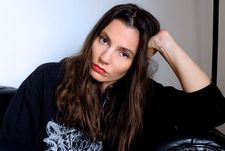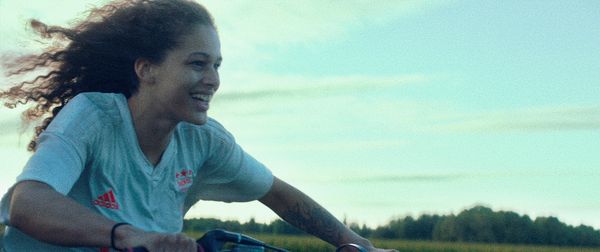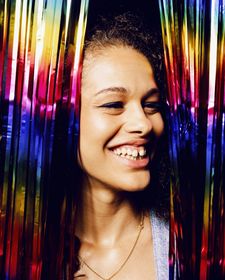Partly based on her own experience of infiltrating the masculine world of motorcycles and the illicit gatherings where the riders show off their bikes and latest daredevil stunts, she explored the closed society in her graduation short Au loin Baltimore? after finishing her studies at the Fémis film school in Paris.
She explains: “I went back there about 50 times and I became friends with the participants. I wanted to understand the environment, its rules, its philosophy and so on. Since 2015 I have spent so much time in this environment, documenting it with clips, short films, and photo reports. To be able to break through with them was quite something. I took a lot of photographs and that in a way gave me an ‘in’ and I shared the images with them.
 |
| Rodeo director Lola Quivoron: 'The writing was very intense over a period of four years but the conception of it from start to finish took around seven years' Photo: Films de Losange |
Was she concerned about impressionable youngsters engaging in dangerous copy-cat stunts after viewing the antics? “Look gangster movies have existed since cinema began and nobody is suggesting that they have influenced the audience to embark on a crime spree! So, no, I don’t have any worries on that score."
The making of the film also was a journey of self-discovery for one of her lead actors Julie Ledru who sits beside her for the interview. “I had never made a film before and it was difficult to adjust to the camera being there, but little by little I got used to it, and also how to play. I was close to the character so the chief cinematographer and I had a good relationship in the sense that he was able to anticipate my movements and so on,” she said.
“My character is a bit of a loner and the anger she feels is because of this solitude. She wants to feel part of a community and a family - and that helps to restore her feelings. In showing the violence of a character you also have to show the kindness and the softness.”
Quivoron developed the characters once she had her cast in place. “I sensed that with Julie and her character Julia there was a real chemistry going on and I adapted the role to suit her personality to a degree. It was a confrontation between the fiction I had been living with for some time and the reality. It all swirled around to become her character who existed in what was a rather toxic and very macho environment.
Then smiling to her co-conspirator Quivoron added: “Julie was incredible, she quickly understood the complexity of this character who is at the same time troubled, violent, manipulative... Like me, she has difficulty identifying herself as feminine or masculine. Julie, Julia and I are "non-binary" beings. Then, from the moment the actor meets her character, you can do anything, you just need to have a little confidence and let yourself be guided. With her, we built this character. We worked on her intensity, her speed (she is always one step ahead), her brutality, and her irreverence. Julia is a chameleon who transforms herself constantly, who changes her appearance, her mask.”
Part of the writing took place during the Covid pandemic when Quivoron discovered the possibilities of the ancient tradition of the Chinese Taoist philsophy. “It seems to suggest that there is no separation between life and death or dreams and reality. Instead you talk about movement … and that lead me to introduce some surreal and fanatical elements in to the imagery of the film.” She was also influenced for the mood of the film by Nicholas Ray’s Rebel Without A Cause and Jean-Claude Brisseau’s Sound And Fury (De bruit et de fureur) from 1988.
Quivoron already has clear views on what kind of directorial path she intends to follow. “I don't like to talk about "directing" actors. It's a term that reminds me more of training ... I prefer to talk about "guiding" the actors. There is no direction. Actors don't know right away how they are going to play this or that scene. Neither do I. We start out together, in the fog, and after a while, things become clearer and the horizon becomes clearer.
"The time we spend searching can’t be shortened and allows us to find the scene. Nothing is ever obvious. Each time, working together allows the deep, magical and imaginary force of a scene to emerge. This is also how the mythology of Rodeo is woven. By letting the unconscious part come out. The actors are at the origin of this magic, of this chemistry. The shooting of a scene is successful when it goes beyond what is written.”
Rodeo is released by Curzon in cinemas and Curzon Home Cinema on April 28























